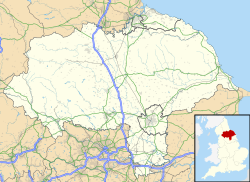
Back York Afrikaans York GSW York AN Eoforwīc ANG يورك Arabic يورك ARZ York AST York Azerbaijani یورک AZB Ёрк (горад) Byelorussian
| York | |
|---|---|
| City | |
 Coat of arms | |
Location within North Yorkshire | |
| Area | 33.7 km2 (13.0 sq mi) |
| Population | 141,685 (2021 census)[1] |
| • Density | 4,204/km2 (10,890/sq mi) |
| Unitary authority | |
| Ceremonial county | |
| Region | |
| Country | England |
| Sovereign state | United Kingdom |
| Areas of the city | List
|
| Post town | YORK |
| Postcode district | YO1, YO10, YO19, YO23-24, YO26, YO30-32, YO41 |
| Dialling code | 01904 |
| Police | North Yorkshire |
| Fire | North Yorkshire |
| Ambulance | Yorkshire |
| Website | york |
York is a cathedral city in North Yorkshire, England, with Roman origins, sited at the confluence of the rivers Ouse and Foss. It has many historic buildings and other structures, such as a minster, castle and city walls, all of which are Grade I listed. It is the largest settlement and the administrative centre of the wider City of York district. It is located 27 miles (43 km) north-east of Leeds, 90 miles (140 km) south of Newcastle upon Tyne and 207 miles (333 km) north of London. York's built-up area had a recorded population of 141,685 at the 2021 census.[1]
The city was founded under the name of Eboracum in AD 71. It then became the capital of Britannia Inferior, a province of the Roman Empire, and was later the capital of the kingdoms of Deira, Northumbria and Scandinavian York. In the Middle Ages it became the northern England ecclesiastical province's centre, and grew as a wool-trading centre.[2] In the 19th century it became a major railway network hub and confectionery-manufacturing centre. In the Second World War York was bombed in the Baedeker Blitz. Although York was less targeted during the war than other, more industrialised northern cities, several historic buildings were gutted and restoration took place up until the 1960s.[3]
Historic local governance of the city was as a county corporate, not included in the county's riding system. The city has since been locally governed as a municipal borough, county borough, and since 1996, a non-metropolitan district (the City of York), which also includes surrounding villages and rural areas, and the town of Haxby. The current district's local council, City of York Council, is responsible for providing all local services and facilities throughout this area.
- ^ a b "Figure 1: Explore population characteristics of individual BUAs" (XLS). Archived from the original on 5 August 2023. Retrieved 7 August 2021.
- ^ "Timeline". York Tourism Bureau. 2005. Archived from the original on 8 January 2008. Retrieved 25 October 2007.
- ^ "When sparks flew across the sky". The Press. Newsquest Media Group. 28 April 2012. Archived from the original on 20 April 2019. Retrieved 20 April 2019.







